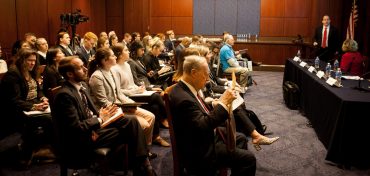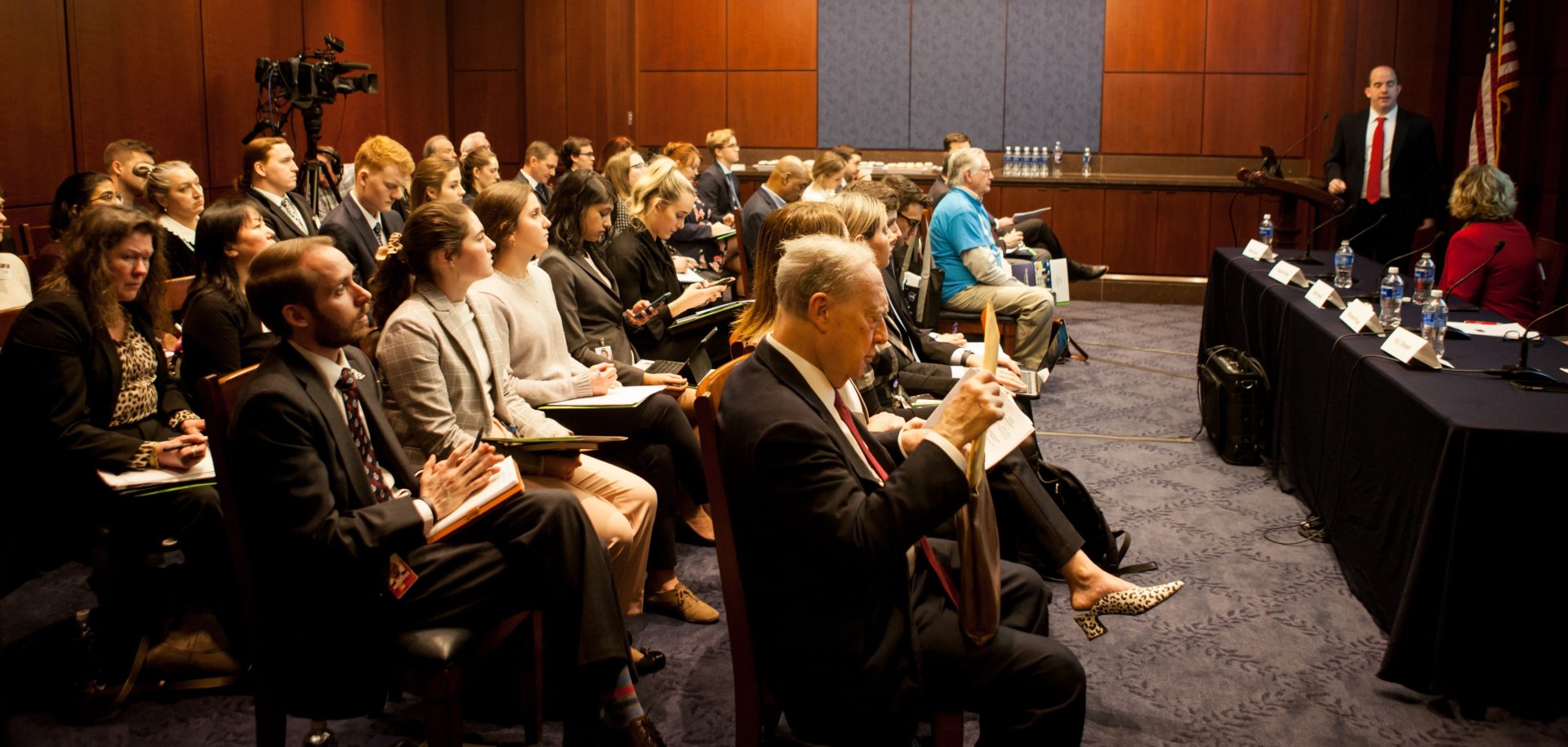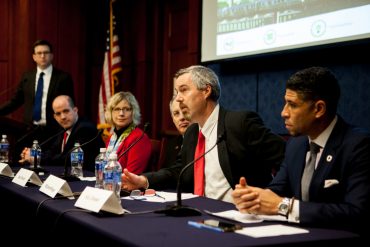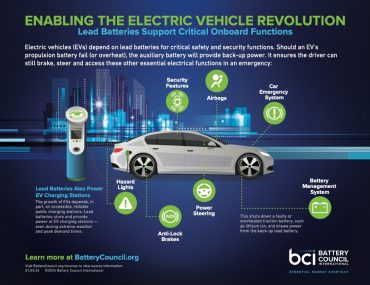 An expert panel briefed policymakers on the role of energy storage in the transition to electrification and decarbonization. Left to right: Dr. Matt Raiford, Angela Rolufs, Alan French, Richard Kluge and H.G. Chissell.
An expert panel briefed policymakers on the role of energy storage in the transition to electrification and decarbonization. Left to right: Dr. Matt Raiford, Angela Rolufs, Alan French, Richard Kluge and H.G. Chissell. Over the next decade, the global battery market is estimated to grow 110%. Driving that growth is a plethora of factors – increased electrification, renewable energy, ensuring backup power for increasing amounts of data and connectivity, and more. These were just some of the many insights on the essentiality of energy storage shared at a Capitol Hill Briefing last week in Washington, D.C.
Battery Council International and Essential Energy Everyday organized the second annual event in advance of National Battery Day on February 18. BCI invited a panel of researchers and experts for a timely discussion on energy storage and the role that lead batteries can play in meeting our nation’s needs. Here are some highlights.



Energy Storage Forecast
Roger Miksad, executive vice president and general counsel of BCI, moderated the event. He began by sharing some additional statistics. Foremost, is that global energy demands, according to some forecasts, are predicted to grow by 122-fold by 2040, which could require upwards of $650 billion of investment. Of that, renewable energy sources will account for almost 40% of that new capacity. He invited the panel to share what it will take for lead batteries to help meet the exponential growth in energy storage needs.
Research and Performance Update
Dr. Matt Raiford, manager of the Consortium for Battery Innovation, gave an overview of how lead batteries are advancing in performance and in mitigating climate change.

“Hybridization is a key strategy in the electrification of our society, and lead batteries play a really significant role as start-stop batteries in automobiles.” It’s a feature that accounts for a 5-to-8% improvement in fuel efficiency, which equates to the removal of 4.5 million tons of greenhouse gas emissions annually in the U.S. “Lead batteries … are strongly contributing to the decarbonization of our society.”
Regarding performance, Raiford said automotive batteries have changed drastically in the last 15 years. “We’re seeing massive gains in the ability of the battery to be recharged quickly. And, over the next five years, the lifetime is expected to increase by almost 50%.” Furthermore, he said lead batteries can fit DOE’s desire to meet performance and cost-effective goals.
A key new market is energy storage systems for micro-grids, photovoltaic solar cell integration, and wind and solar energy in both residential and commercial applications. CBI’s research has found that lead batteries can provide safe, reliable power to these markets at an accessible cost, with more performance enhancements expected.
He noted the current research collaborations underway at the Department of Energy’s Argonne National Laboratory, UCLA and others to access the untapped potential of lead batteries.
EV Fast Charging Project Update
Angela Rolufs is vice president of strategic energy initiatives at Paragon Business Solutions. She gave an overview of a collaborative feasibility study happening on integrating lead batteries in electric vehicle DC FC (direct-current, fast charging) stations in Missouri.
The project explores the role lead batteries can play in mitigating power demand fluctuations and lowering drawn-down costs.
Rolufs explained how onsite lead batteries can charge and discharge using direct current. Batteries charge from the grid when demand is lower, store the power, and release it when demand is higher. When an EV car arrives, the battery can quickly deliver electricity to the EV charger without drawing power form the grid, avoiding demand charges.
“The timing is right for advanced lead battery storage,” Rolufs concluded.
Data Center Growth and Resiliency
QTS Data Centers is a leading provider of data center solutions across North America and Europe. Alan French, QTS’ vice president of engineering, stressed three points: Data is critical. Data is growing at a rapid rate, and battery systems are essential in keeping data centers resilient and available.
“The growth of data is profound. We send 2.5 million emails every second.” The growth will continue, with the advent of AI, VR and machine-learning. “It’s moving us to a new edge, and batteries are key to what we do.” In the U.S., $360 million was spent last year on building data centers.
He also discussed his company’s progress in sustainability. “Our goal is to procure 100% of our power from renewable sources by 2025.
We are a third of the way there, using solar power and wind power.” He added how the circularity of lead batteries is also key to meeting QTS’ sustainability objective. “We have a great partner in lead batteries. No other product … is recycled more than them.”

Telecommunication Battery Safety
Richard Kluge is with Ericsson, Inc., a world leader in providing Information and Communication Technology (ICT) to service providers. He explained how critical lead batteries are for the safe, sustainable delivery and continuous availability of our telecommunication system to support emergency and medical services.
Kluge also stressed the need to customize battery safety standards and codes. “Standards must be based on the safety of the chemistry, the applications, and the safety of the occupants.”
To demonstrate this, he explained the differences in lead batteries and lithium-ion batteries. Lead batteries have some inherent safety qualities. For example, electrolyte, though acidic, is 70% water, non-flammable and with lower water reactivity. A lead battery’s plastic case can also be specified as highly fire resistant.
In contrast, many of the lithium-ion electrolytes can be highly flammable. These fires are difficult to suppress and can cause a chain reaction. Fire codes were recently changed to address firefighter concerns primarily with lithium-ion proliferation in energy storage applications.
Meeting 2050 Decarbonization Goals
Concluding the briefing was an expert coming from the front lines of energy storage. H.G. Chissell, founder and CEO of Advanced Energy Agency (AEA) and Advanced Energy Group (AEG), works with major U.S. city governments, including New York City, Chicago and Washington, D.C., on how to deliver on “Decarbonization by 2050” goals.
He stressed the importance of building consensus by having diverse stakeholders – utilities, commissioners, heads of public housing authorities, mayors’ offices – come together to align on the problem, solution and call to action.
He agreed on the critical importance of battery storage in decarbonization, and specifically, lead batteries. “This vision of decarbonized cities running off renewable energy … that is uncontrollable energy. It will need a buffer and that’s what battery storage provides. For that to happen, we have to re-evaluate and appreciate what lead batteries bring to the table.”
Conclusion
We encourage you to view the entire briefing here.






